Small Business Credit Insights
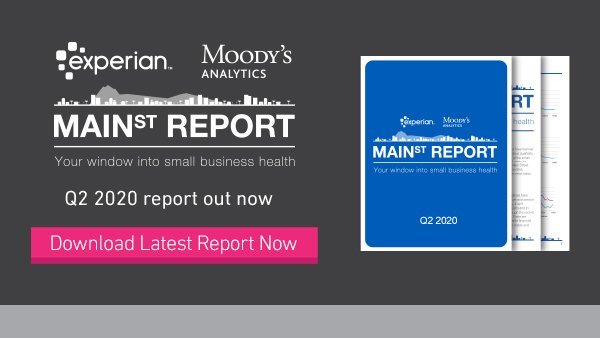
Experian and Moody's Analytics have just released the Q2 2020 Main Street Report. The report brings deep insight into the overall financial well-being of the small-business landscape, as well as offer commentary on business credit trends, and what they mean for lenders and small-businesses. Small businesses have turned to borrowing to survive periods of prolonged slumping sales, in many cases from government programs offering loan forgiveness. This increased borrowing has masked rising delinquent balances, but such a solution is a short-term fix. To keep their credit current, small businesses will need to find ways to generate revenue. Defaults are expected to rise in coming quarters as forbearance programs expire and as customers are likely to change their priorities in the wake of COVID-19. In Q2, moderate delinquency, defined as 31-90 days past due, rose to 1.66 percent from 1.61 percent, marking the fourth consecutive quarter of increasing delinquency, and the first year-over-year increase since this time last year. The closure of many state and local economies in April and the first half of May left many businesses facing severe revenue shortfalls in the second quarter. This environment has resulted in businesses listing poor sales as the second most important problem facing small businesses, according to the NFIB. If you would like to get the full analysis of the data behind the latest Main Street Report, presented by leading economists from Moody's Analytics and Experian, watch the Quarterly Business Credit Review webinar.
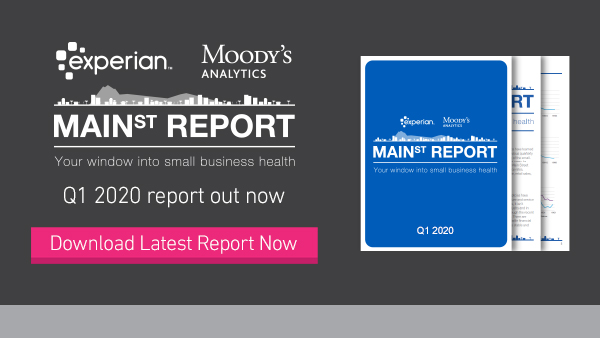
Experian and Moody's Analytics have just released the Q1 2020 Main Street Report. The report brings deep insight into the overall financial well-being of the small-business landscape, as well as offer commentary on business credit trends, and what they mean for lenders and small-businesses. After just one quarter, there’s no doubt the theme of 2020 is the pandemic, Covid-19. Unrelated to the pandemic, and subsequent shuttering of a swath of economies across the world, delinquencies rose in the first quarter. This was occurring as businesses reduced their borrowing. Lower borrowing will not have lasted long though, as government efforts to aid small business have taken the form of SBA lending. In Q1, the slowing of businesses pursuing credit pushed moderately delinquent balances up to 1.61 percent from 1.60 percent in the fourth quarter of 2019. # DPD Q1 19 Q4 19 Q1 20 Moderately delinquent 31–90 1.74% 1.60% 1.61% Severely delinquent 91+ 3.35% 2.29% 2.68% Bankruptcy 0.16% 0.16% 0.16% The bankruptcy rate was essentially flat in the first quarter, rising to 16.3 basis points from 16.1 in Q4. But the rate increased as fewer firms were reported as having active credit balances. The Federal Reserve’s Senior Loan Officer Survey indicates lenders are seeing higher demand than usual for Commercial & Industrial loans. This indicates the beginning of increasing loan demand this year, as small firms look to borrow to ride out lower consumer demand and remain in business. Watch the Quarterly Business Credit Review Get the full analysis of the data behind the Main Street Report by watching the experts from Experian and Moody’s in the Quarterly Business Credit Review.
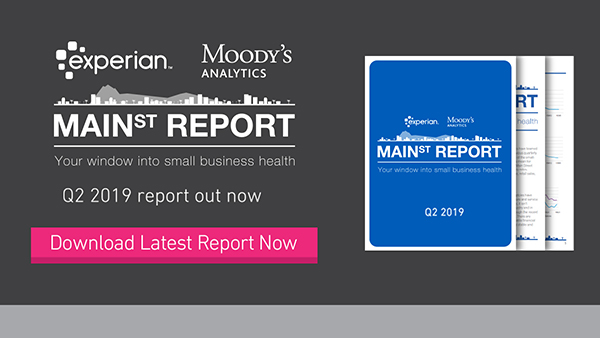
Experian and Moody’s Analytics have just released the Q2 2019 Main Street Report. The report brings deep insight into the overall financial well-being of the small-business landscape, as well as providing commentary on what certain trends mean for lenders and small businesses. Q2 Highlights In spite of business confidence in the second quarter, shaken by talk of trade war escalation, small businesses got a helping hand from seasonal factors that combined to push delinquency rates down. Delinquency rates for businesses with fewer than 100 employees fell in the second quarter, decreasing the 31–90 days past due rate from 1.74 percent to 1.64 percent for the quarter. But agriculture’s problems continued as weather and trade conditions continued to weigh on small farms. These factors won’t be as helpful in the third quarter, so fundamentals or confidence will need to improve to propel performance and growth forward. Bankruptcies ticked up ever so slightly again in the second quarter coming in at over 16 basis points. The most recent data available, from Q4 2018, indicates an establishment growth rate of 2.3%. Enough of these new businesses will seek credit to ensure that, combined with existing borrowers, balances look set to grow for some time. Overall, small businesses continue to display little to no signs of broad-based weakness. What weakness exists is fairly well confined at either the regional or industry level, and the solid performance that has been the norm for the last several quarters looks set to continue. Watch Webinar Recording Experian and Moody's Analytics go in-depth on the Q2 2019 Main Street Report in the below webinar.
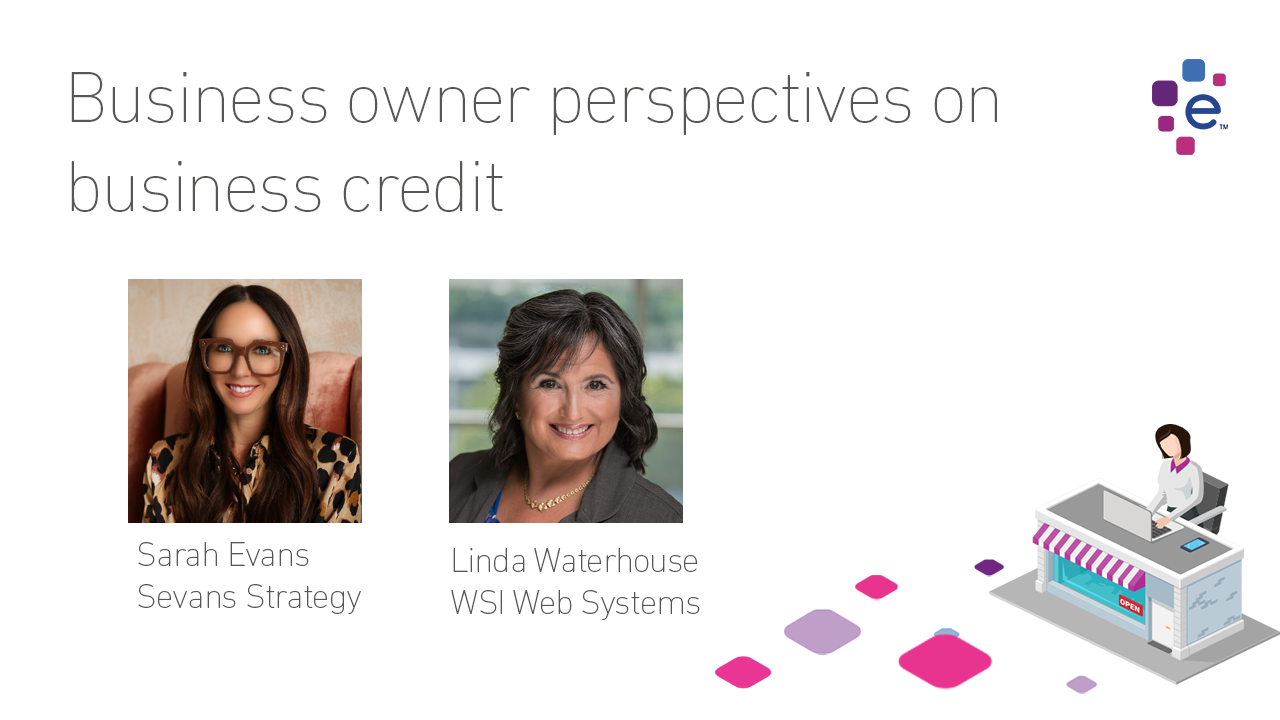
Experian has just released the Women in Business credit study, which is a three year study of around 2.8 million credit files for small business owners, and one of the key findings in this study was that, women business owners in particular, are reliant upon personal forms of credit, and they may be at a disadvantage through this practice. So we wanted to talk to some women business owners about business credit. First up is Sara Evans from Sevans Strategy. Experian: Sarah, could you tell us a little bit about your business and how you got started in PR? Sarah Evans: Certainly, I was a PR major in college. And, when I originally graduated I was very interested in the nonprofit sector, so I went to work for the largest health care system in Illinois, and focused heavily on communications, internal comms and government relations. From there did some PR agency work and then became director of communications for a small community college. And throughout all of that it was at the time of emerging media or digital media and I was a bit far ahead of my nonprofit hat that I was wearing. So, at night I would go home and consult for companies and businesses who are ready to do emerging technologies, planned and implement them and essentially worked myself out of a job and have now had my company Sevens Strategy for the past 10 years focused specifically on digital PR? Experian: Do you rely on personal forms of credit for your business? Sarah Evans: I am completely self-funded. In fact, when I transitioned out of my traditional day job I had an amazing boss at the time. We did a three month exit strategy, so they could find my replacement. And so, I could also build up enough business, steady business to be able to move forward. And, because of that I believe I set myself up in a way that it has, it has done well. Experian: Have you ever run your business credit report? Sarah Evans: I haven't. Perhaps I should. I know Experian could probably help me with that. Experian: Well our study revealed that many women business owners will fund their operation through personal forms of credit. Is that something that surprises you? Sarah Evans: It doesn't surprise me, no. I think some of it is, for example when I decided to get into business for myself, I didn't have necessarily the business acumen or the background or a business degree. A lot of it I learned on the go. So, you take your habits or best practices that you may already use in your everyday life and just transition them over to business. I think a lot of it is learn as you go or finding and learning from industry experts that can help you do better. Experian: So do you think there's a need for additional resources around building strong credit and best practices in business credit? Sarah Evans: I think there is a huge opportunity and in fact if it already existed I would have had no idea. I also think it's important for this up and coming generation especially as we see an uptick in the rise of entrepreneurs. Every day we see new businesses and product ideas that are launching. There are prime candidates out there that may be great at honing an idea or bringing a business plan to life but not sure about the financial aspect of it. It'd be great to have a partner and a resource area where you could go to, and not just from the credit bureaus themselves or financial institutions themselves, but from trusted business resources who might work with them. So that I don't feel like I'm going all in on an institution that I may not have full trust in, but I might trust someone that they work with or that has used them already. Experian: Well thanks for coming on and sharing about your business Sarah. Sarah Evans: Thanks so much Gary. Experian: Well next we're going to speak to Linda Waterhouse and she is the owner of WSI, a digital agency. Linda, can you tell us what your business is primarily focused on right now? Linda Waterhouse: Yes, I am a digital marketing strategist, and I focus on helping professional women use LinkedIn for lead generation. Experian: Ok that's great. And so how long has your business been in business? Linda Waterhouse: My business. I've been running my business for about six years now. Experian: So how do you feel about taking on debt for your business? Linda Waterhouse: I have so far just invested our personal money rather than going outside to a bank or other lending facility to get a loan. Experian: So, can you tell us why you have used personal forms of funding for your business? Linda Waterhouse: I haven't really relied on like personal credit cards. I've delved into our long-term savings with the intent of paying it back. Part of that was because I thought that it was less expensive to not pay interest on that. All we would be losing is the interest that that money would be earning and since interest levels are low right now, I didn't think that that would be as significant as if I were to go out and get a loan, and I don't know what the interest rates are, you know, 5, 10 percent. So it seemed like a more economical way for me to start my business. Experian: And can you talk a little bit about the growth of your business? Linda Waterhouse: This year I decided that I was really going to focus on one social platform which is LinkedIn, and to help women business owners primarily learn how to use it for lead generation, because many people still think of LinkedIn as just for job searchers and recruiters. Experian: So Linda, have you run your own business credit report? Linda Waterhouse: Oh, you caught me. No, I haven't because I don't have any immediate plans to take a loan. So I have to say that I do not have any credit or I don't know what my credit score is. Experian: So, if there were resources on building and maintaining strong credit, would you take advantage of those resources? Linda Waterhouse: Yes. And I think taking people through the process would help starting or creating another opening another credit card is something that I've done personally? So, opening one for my business is very familiar and I can do it online. I have no idea how to do a business loan. I don't know which bank to pick. So, that's you know the unknown is always something that people are going to be wary of. Experian: Last question. What do you like most about being a business owner? Linda Waterhouse: The best part of being a business owner who works in digital or online is the fact that I can work from nearly anywhere. I recently accompanied my husband on a trip to Brussels in Amsterdam. He had work there, and I went with him and I could keep up with my work when I was there. So we were able to have a longer stay there than I would have been able to had I been tied to work here in New Jersey.
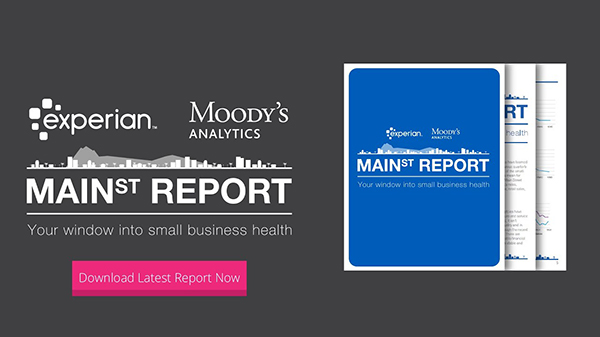
Experian and Moody’s Analytics have just released the Q1 2019 Main Street Report. The report brings deep insight into the overall financial well-being of the small-business landscape, as well as providing commentary on what certain trends mean for lenders and small businesses. In Q1 U.S. small businesses brushed off a government shutdown as stock markets recovered and income gains remained steady. Delinquency rates remained mostly stable, with pockets of weakness spread out among regions and industries, notably agriculture in the Great Lakes and manufacturing in the Southwest. Small firms seem to have simply shrugged off the headwinds of the first quarter and kept on with business as usual. Despite a fresh escalation in trade tensions, the year is starting off well with positive news coming from the areas presenting risks to the outlook. A dovish stance on interest rates from the Federal Reserve and room to grow in our housing market — 2019 is off to a strong start. Watch Webinar Recording - Q1 2019 Quarterly Business Credit Review Listen to the experts from Experian and Moody's Analytics go in-depth on insights revealed in the Q1 2019 Experian/Moody's Analytics Main Street Report.
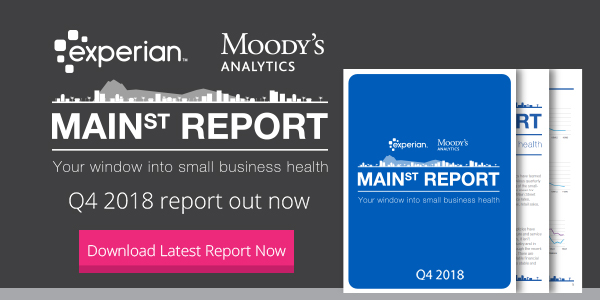
Experian has released the Experian/Moody's Analytics Main Street Report for Q4 2018. The report brings deep insight into the overall financial well-being of the small-business landscape, as well as providing commentary around what certain trends mean for credit grantors and the small-business community. Bucket 17Q4 18Q3 18Q4 Moderately Delinquent 31-90 1.68% 1.63% 1.68% Severely Delinquent 91+ 4.00% 3.40% 3.49% Bankruptcy BKC 0.16% 0.16% 0.16% The fourth quarter capped a second year of solid performance and growth for small-business credit, but there are signs that the period of moderation experienced during the past two years is over. Since the government shutdown has the potential to throw small-business lending a curve ball in the first half of 2019, the outlook for small-business credit is neutral. Conditions were positive in the fourth quarter, but this may not last long. Delinquency rates remained mostly stable, with pockets of weakness spread out among regions and industries, notably construction in the Plains. In addition to the 35-day shutdown, rising interest rates, destabilizing trade policy and slowing home-price growth are potential trouble sources that are already starting to impact some regions.
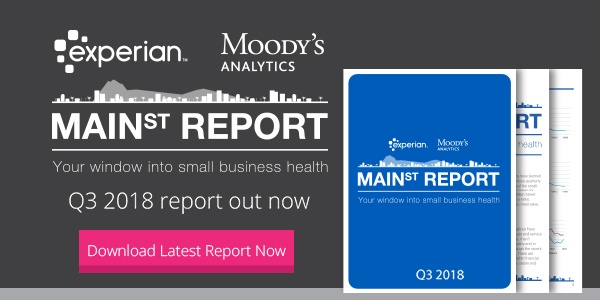
Today Experian and Moody's Analytics released the Q3 2018 Main Street Report. The report brings deep insight into the overall financial well-being of the small-business landscape, as well as providing commentary around what certain trends mean for credit grantors and the small-business community. For Q3 2018, the overall outlook for small-business credit is positive, but some industries such as construction have a negative outlook. Delinquency rates stable for now Delinquency rates are stable around their current levels, but this could change quickly if risks mount for certain industries. Continuing strength in the economy should keep small-business credit performance in check through the fourth quarter and early next year. Rising interest rates, destabilizing trade policy and slowing home-price growth are potential sources of trouble that are already starting to impact some regions. To bring insight to these Q3 business credit findings, Experian and Moody's Analytics will be presenting the Quarterly Business Credit Review for Q3 2018 on Tuesday, December 11th 10:00 a.m. (Pacific) 1:00 p.m. (Eastern). Read the report and bring your questions, we will be opening up the session for live Q&A as we dig into the numbers and the outlook for Q4 2018. We hope to see you there. Presenters: Gavin Harding Derrek G. McCrank Cristian deRitis
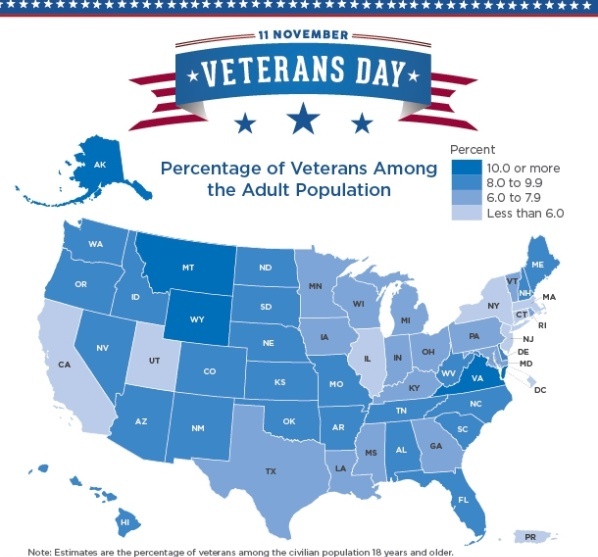
Today we are celebrating Veterans Day in the United States. With deep gratitude for their service and the many sacrifices made for our country, Experian salutes Veterans across the country, and around the world, and we extend our warmest wishes for a Happy Veterans Day. So, where are our Veterans? Well, according to the U.S. Census many of our Veterans are located in Montana, Wyoming, Virginia and Alaska. [Source: U.S. Census Bureau] Veterans Day originated as “Armistice Day” on Nov. 11, 1919, the first anniversary marking the end of World War I. Congress passed a resolution in 1926 for an annual observance, and Nov. 11 became a national holiday beginning in 1938. President Dwight D. Eisenhower signed legislation in 1954 to change the name to Veterans Day as a way to honor those who served in all American wars. The day honors military veterans with parades and speeches across the nation and a remembrance ceremony takes place at the Tomb of the Unknowns at Arlington National Cemetery in Arlington, Va. The ceremony honors and thanks all who served in the U.S. armed forces. Did You Know? 18.2 Million The number of military veterans in the United States in 2017. 1.6 Million The number of female veterans in the United States in 2017. 50.0% The percentage of veterans age 65 and older in 2017. At the other end of the age spectrum, 8.9 percent were younger than age 35. Veteran-owned Businesses in the U.S. In the US there are around two and a half million businesses that are majority-owned by veterans and growing. Veteran-owned firms have receipts in excess of a trillion plus dollars, and annual payroll of almost $200 billion. These are not insignificant figures as Veteran-owned small business owners drive to succeed in their business while supporting job growth. To perform well they need continued support and commercial credit can be an invaluable tool to an emerging business and its longevity and stability in the small business development. Veteran Strength Experian commercial credit data on Veteran-owned businesses highlights remarkable similarity between veteran owned businesses and the industry overall in terms of sales, commercial credit quality, indebtedness, and credit utilization. Stability Veteran-owned businesses typically employ more people, and show remarkable stability in terms of commercial risk and delinquency. Most Veteran-owned businesses are small and emerging. A positive trend in small business launches in recent years has resulted in a downward trend in the statistic below as more small businesses emerge in the 1-4 employee range and work to grow and survive in market. Avg. Owner Employee Size Infogram Infogram Veterans who own businesses in the US are an average of 4 years older than their civilian counterparts, and are 10% more likely to own homes. The strength of the housing market in the past few years has given small business owners the ability to source equity from their homes to strengthen their small business and to thrive. Veterans are applying the tools, learning, work ethic and dedication learned from their military service to build stable businesses that support employment and the small business ecosystem. We expect credit performance in the U.S. to remain strong in the short term but signals of approaching resets could change and impact the market in the short term. Veteran-led businesses will continue to charge forward and remain a vital part of our economy.
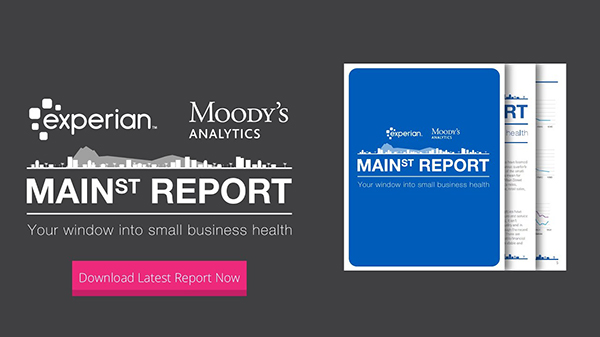
Today Experian Business Information Services releases the Experian/Moody's Analytics Main Street Report for Q1 2018. The report brings deep insight into the overall financial well-being of the small-business landscape, as well as providing commentary around what certain trends mean for credit grantors and the small-business community. Q1 2018 saw credit conditions loosening and balances rising as more businesses access credit. The report states the overall outlook for small-business credit is positive. Delinquencies were down and default rates rose slightly, suggesting that credit conditions have peaked as the economy is in a late-cycle expansion. Continuing strength in the macroeconomy will keep small-business credit moving in the near term, along with higher profits from the recently passed tax legislation. Small-business credit will be less certain in the medium to long term as rising wages, interest rates and changes to the tax code take a toll. Download the latest report
